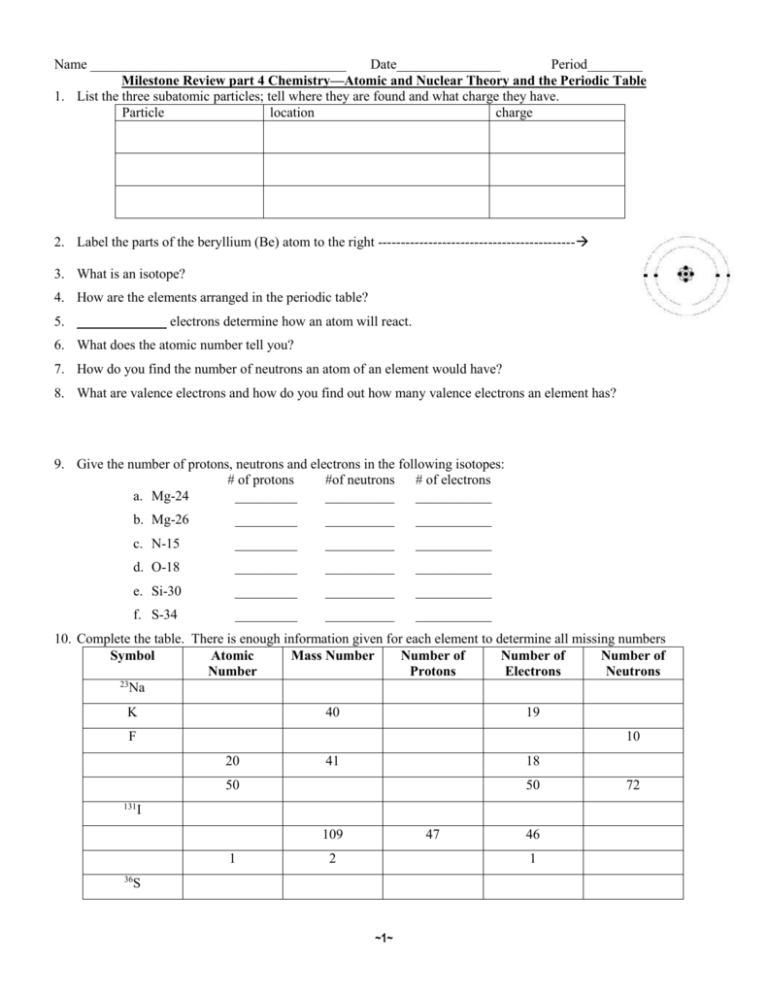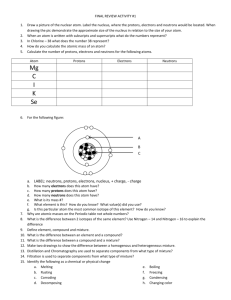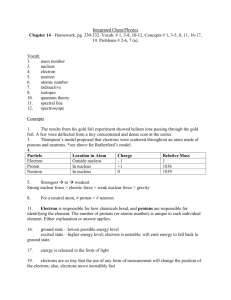Milestone review part 4 Chemistry Periodic Table and Atomic Theory
advertisement

Name _____________________________________ Date_______________ Period________ Milestone Review part 4 Chemistry—Atomic and Nuclear Theory and the Periodic Table 1. List the three subatomic particles; tell where they are found and what charge they have. Particle location charge 2. Label the parts of the beryllium (Be) atom to the right ------------------------------------------- 3. What is an isotope? 4. How are the elements arranged in the periodic table? 5. _____________ electrons determine how an atom will react. 6. What does the atomic number tell you? 7. How do you find the number of neutrons an atom of an element would have? 8. What are valence electrons and how do you find out how many valence electrons an element has? 9. Give the number of protons, neutrons and electrons in the following isotopes: # of protons #of neutrons # of electrons a. Mg-24 _________ __________ ___________ b. Mg-26 _________ __________ ___________ c. N-15 _________ __________ ___________ d. O-18 _________ __________ ___________ e. Si-30 _________ __________ ___________ f. S-34 _________ __________ ___________ 10. Complete the table. There is enough information given for each element to determine all missing numbers Symbol Atomic Mass Number Number of Number of Number of Number Protons Electrons Neutrons 23 Na K 40 19 F 10 20 41 18 50 131 50 I 109 1 47 2 46 1 36 S ~1~ 72 11. What is radioactivity? 12. What is half-life? 13. If we start with 400 atoms of a radioactive substance, how many would remain after one half-life?____________ after two half-lives? _____________ after three half-lives? _____________ after four half-lives ____________________? 14. A paleontologist discovered fossil remains of ancestral mammal, and in order to have basis of comparison to other ancestral mammals, he needed the age of the fossil. The carbon-14 analysis indicates that only half of the original amount is present. How old is this fossil? 15. The half-life of hydrogen-3 is 12.3 years. Given 100 g of hydrogen-3, how many grams will be left after 5 halflives? 16. A patient is administered 20 mg of iodine-131. How much of this isotope will remain in the body after 40 days if the half-life for iodine-131 is 8 days? 17. The mass of cobalt-60 in a sample is found to have decreased from 0.8 g to 0.2 g in a period of 10.5 years. From this info, calculate the half-life of cobalt-60 18. The three most common states of matter are _____________, _____________ & _____________. 19. The kinetic theory states that the higher the temperature, the (faster / slower) the particles that make up a substance move. 20. As a sample of matter is cooled, its particles move more (slowly / quickly). 21. The particles that make up a solid move ____________ than do the particles that makes up a gas. 22. Matter that has a definite volume but no definite shape is a ______________. 23. Matter that has a definite volume and a definite shape is a _____________. 24. If you move a substance from one container to another and its volume changes, the substance is a ___________. 25. 26. 27. 28. In the above picture, which substance is a liquid? In the above picture, which substance is a solid? In the above picture, which substance is a gas? In the above picture, which substance are the forces of attraction among the particles so weak that they can be ignored under ordinary conditions? 29. Based on the information in the table above, the melting point of acetic acid is_________. 30. Based on the information in the table above, the freezing point of nitrogen is ___________. 31. Based on the information in the table above, which substances would be a gas at 0ºC? ~2~ 32. A solution is a __________________ mixture of two or more components. 33. The ___________ is the component in the greatest amount. 34. The ___________ is the component in the least amount 35. In a mixture, the ___________________ dissolves in the ______________. 36. If you dissolve sugar in water, which is the solvent and which is the solute? Water = ________ Sugar = ______ 37. Soft drinks consist of a mixture of water, sugar, and flavoring, with carbon dioxide gas bubbled through it. Which of these ingredients would be considered the solvent? 38. Dry air is primarily made up of nitrogen (78.09%) and oxygen (20.95%). Which of these is the solvent and which is the solute? Nitrogen = _________________ Oxygen = ______________ Classification of Matter—Know definition of Matter; Be able to give examples of and tell difference between: Mixtures and substances (non-mixtures); Homogenous and heterogeneous mixtures; Elements vs. Compounds. Label as Mixture or Pure Substance 1. Pure substance a. Made up of two types of matter that can be Salt Water _____ Chicken Soup ______ 2. Mixture physically separated. 3. Heterogeneous b. Two samples might not be the same. Water _________ Salt _____________ Mixture c. Two samples will have the same makeup. Silver ________ Chex mix __________ 4. Matter d. Has only one kind of atom in the sample. Label as Homogenous or Heterogeneous 5. Element e. Contains two kinds of atoms that cannot be Sugar Water ____ Vegetable Soup ____ 6. Homogeneous physically separated. Mixture f. Cannot be separated by physical means. Chex Mix ______ Jello w/ fruit ______ 7. Compound g. A classification of anything that has mass Milk _________ Plain Jello ________ and takes up space. Write the metric prefixes in order from largest to smallest: Convert the Following Identify Physical or Chemical Change 3.2 kilometers = ____________ meter Sugar dissolved in water ______________________ 0.23 centimeters = __________ millimeters Wood burning ______________________________ 0.12 liter = ___________ milliliters Digestion __________________________________ 2500 millileters = ___________ liters Water Boiling ______________________________ 4500 grams = ______________ kilograms Two liquids bubble when mixed ________________ 9 kilograms =____________ grams Cooking food _______________________________ 54 megaliters = ______________ centiliters Melting butter ______________________________ Circle the indicators of physical changes Underline the indicators of a chemical change Melts Produces gas Changes in color Circle the acids and underline the bases H2(PO4) HF Ca(OH)2 NaOH Ca(OH)2 HNO3 ~3~ Changes Smell Ripped Cutting Boils Turns cloudy Changes taste Breaks Dissolves freezing 1. Proton a. 2. Neutron b. 3. Electron c. 4. Nucleus d. e. 5. Atom f. Particles with no charge that exists in the nucleus of most atoms. Center of the atom, contains most of the atom’s mass. Positively charged particle in the nucleus of the atom. The smallest part of an element or molecule. Negative particles in the nucleus of the atom. Negatively charged particle that exists in the space around the nucleus. Solution (So); Colloid (C); Suspension (Sp) Milk in water ________ Doesn’t settle; scatters light ______ Vinegar in water _____ Doesn’t scatter light or settle ______ Sand in water _______ Settles and scatters light _______ 1. Atomic Number a. Total number of protons and neutrons in the nucleus of an atom. b. Number of protons in an atom; 2. Molecule also the way the elements are numbered. 3. Compound c. An atom with a different number of neutrons 4. Mass d. Two or more elements combined. Number e. Two or more atoms that are combined 5. Isotope f. Number of electrons in an atom. The temperature at which a solid turns to liquid is called: The temperature at which a liquid turns to a gas is called: The temperature at which a gas turns to liquid: Oil and water ______ Fog _________ Milk _________ The temperature at which a liquid turns to a solid: When a solid turns straight to a gas is called: At what temperature does water melt? At what temperature does water boil? Endothermic or Exothermic 1. If it gets cold _______________________________ 2. If it gets hot _______________________________ 3. Condensation: _____________________________ 4. Vaporization: ______________________________ 5. If it absorbs heat_____________________________ 6. If it releases heat_____________________________ 7. Melting _______________________________ 8. Freezing _______________________________ Give the group/family name for the following groups on periodic table Group 1: _______________________________ Group 2: _______________________________ Group 13: _______________________________ Group 14: _______________________________ Group 15: _______________________________ Group 16: _______________________________ Group 17: _______________________________ Group 18: _______________________________ Reading Chemical Equations Li2O + MgCl2 → 2 LiCl + MgO 2 C3H7OH + 9 O2 → 6 CO2 + 8 H2O Write the second reactant: _______________________ Write the first product: ________________________ Write the first product:____________________________ How many carbons on the reactant side? _____________ How many Lithium atoms are on the product side? _____ How many hydrogens on the product side? ___________ What is coefficient for lithium chloride? ___________ What is the coefficient for carbon dioxide? ___________ Type of reaction: ___________________________ Type of reaction: ______________________________ ~4~








